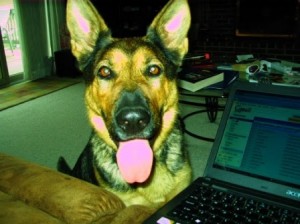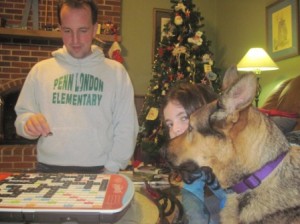 Can I talk to you about dogs’ ears? Strange topic, I know, but as a lifetime “cat person,” I really never grasped the communication potential of these limber appendages until Sorcia came into our lives. (Cats express their emotions — mostly disdain and irritation — through a twitching tail.)
Can I talk to you about dogs’ ears? Strange topic, I know, but as a lifetime “cat person,” I really never grasped the communication potential of these limber appendages until Sorcia came into our lives. (Cats express their emotions — mostly disdain and irritation — through a twitching tail.)
It’s amazing how expressive a German Shepherd’s ears can be. They are so huge and pointy and flexible – and they are so in tune with her expressions. And yes, she uses them to manipulate us.
When Sorcia is alert – or trying to look extra cute – they stand straight up at attention. This is her I-Love-You-Do-You-Have-Chicken-For-Me? pose. Yes, we feed her raw chicken. Yum.
Of course, ears flat down on the back of her head is a sad, sad doggie. Reprimand her, and that’s what you get. She also uses it to look really pitiful when she’s outside the door and wants to come in. “Ears down” has become our family phrase to express unhappiness.
Bob: They didn’t have your brand of yogurt at the grocery store, Dianne.
Dianne: Oh, ears down, Bob. Ears down!
I had no idea that German Shepherds can make their ears do two separate things! For example, if Bob reprimands Sorcia for wanting to eat the toy poodle next door, she will flatten the ear next to Bob (Total submission to you, Alpha Male), while pointing the other ear aggressively toward that poodle. (You just wait until he’s not around!!!)
We especially love the swiveling radar dish ears, which comes along with a cocked head for times when Sorcia is puzzled. The children’s voices coming out of the intercom box? That gets us the swiveling ears. She can hear the children, but that box is not the children. How confusing! Swivel ears, cock head; swivel ears the other way, cock head.
And finally, one ear forward and one back is for frustration, such as when she sees a really high-scoring word in Scrabble and it’s killing her because she can’t tell us.


This made me miss having a dog. Expressive ears are the best.
Love this post! Too bad people don’t have those kind of ears.
HAHA! EARS DOWN! I’m totally using that! Sorcia looks so happy in the 1st pic!
Animals are the best, aren’t they? We’ve had many dogs in the past, but currently have two cats. They’re more subtle than dogs, but they get their point across, too. (Dontcha love that pointed backside-to-you thing they do when they’re annoyed?)
I LOVE your family expression for unhappiness! I used to have a German Shepherd, Marcus, but now I have a lab and his ears are forever down and floppy. He’s also about half as bright as a Shepherd. Maybe. If he’s lucky.
You know I can relate to this one! My lab Hank was extremely expressive. If I told him to get off my lap, he turned his head away and looked down as if his feelings had been hurt. When I whispered, “Get the squirrel!”, one eyebrow went up, and both eyes darted around madly. This was just the beginning of his repertorie of facial expressions. And I too will have to steal “ears down”.
hi miss dianne! for sure i love animals and you know sorcias tops on my doggy list. wow she got the most cool ears. most animals could hear good and could move their ears but i think no one didnt ever talk about it before. for sure talking bout dog ears it a thing you could think of. ha ha.
…big ears up hugs from lenny and a pat on the head for sorcia
so cute! I always wondered about german shepard ears. Are they born pointy or do you have to have ’em clipped? My dog Rudy has his own methods of conversation too, talks alot with those eyes.
XD This is great…my cat Ronny has his own…ah…’unique’ way of expressing himself as well 🙂